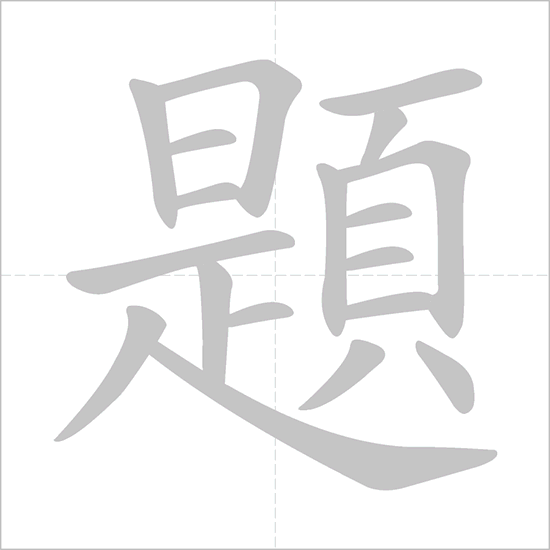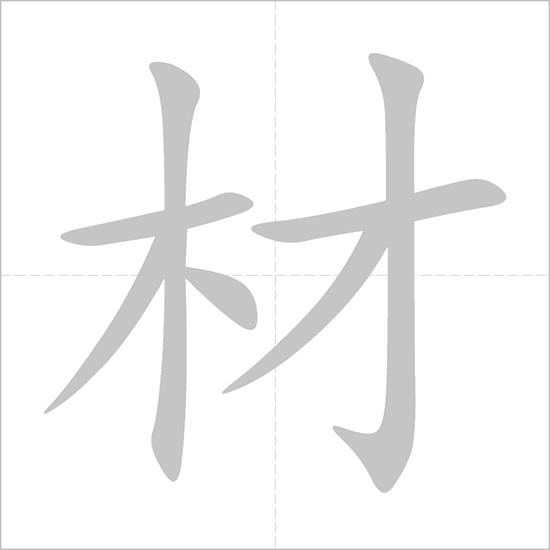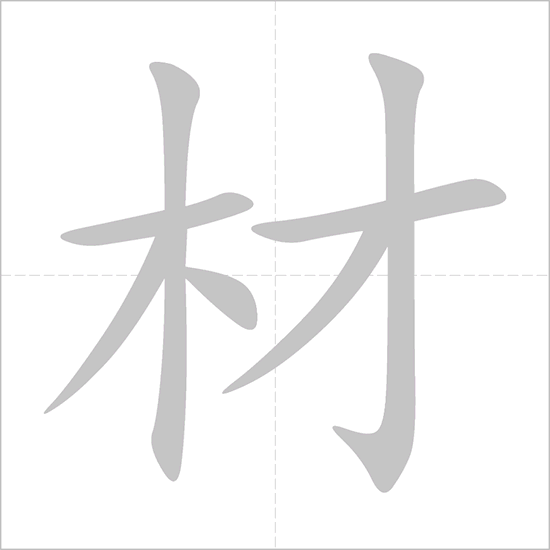Showing Results in:
- ENGLISH
- SEE TRADITIONAL
- SEE CANTONESE
-
Tone
Phonetics: Tone colors (āáǎàa):
Recent Searches:
Learn more about 題材
- Written Chinese
- Dictionary
- "題材" Character Details
| Pinyin | Yale | Jyutping | English Definition for Chinese Text |
|---|---|---|---|
| tai4 choi4 | tai4 coi4 | subject matter |
| Traditional Chinese | Pinyin | Yale | Jyutping | English Definition for Chinese Text |
|---|---|---|---|---|
| tai4 | tai4 | topic / problem for discussion / exam question / subject / to inscribe / to mention / surname ti | ||
| choi4 | coi4 | material / timber / ability / aptitude / a capable individual / coffin (old) |
How do you remember 題材 ?
Post your photos, example sentences and daily homework here to share with the Chinese learning community.
How to use 題材 in a Sentence
Subjects like this are better left alone.
He directed various TV shows.
A novel about being down and out in London
- 這 zhè
- 是 shì
- 大 dà
- 多 duō
- 數 shù
- 標 biāo
- 註 zhù
- 的 de
- 電 diàn
- 視 shì
- 幽 yōu
- 默 mò
- 劇 jù
- 所 suǒ
- 採 cǎi
- 用 yòng
- 的 de
- 題 tí
- 材 cái
- . .
This is the stuff most stadard TV sitcoms are made of.
- 她 tā
- 最 zuì
- 喜 xǐ
- 愛 ài
- 的 de
- 題 tí
- 材 cái
- 是 shì
- 那 nà
- 些 xiē
- 在 zài
- 海 hǎi
- 邊 biān
- 散 sàn
- 步 bù
- 時 shí
- 發 fā
- 現 xiàn
- 的 de
- 貝 beì
- 殼 ké
- 。 。
Her favourite subjects are shells spotted on beach walks.
- 敵 dí
- 對 duì
- 兩 liǎng
- 黨 dǎng
- 之 zhī
- 盛 shèng
- 衰 shuāi
- 給 gěi
- 兩 liǎng
- 幅 fú
- 最 zuì
- 優 yōu
- 秀 xiù
- 的 de
- 漫 màn
- 畫 huà
- 提 tí
- 供 gōng
- 了 le
- 題 tí
- 材 cái
- . .
The ups and downs of the rival parties furnished subjects for two excellent cartoons.
- 我 wǒ
- 發 fā
- 現 xiàn
- 媒 méi
- 體 tǐ
- 越 yuè
- 來 lái
- 越 yuè
- 沉 chén
- 湎 miǎn
- 於 yú
- 淫 yín
- 穢 huì
- 下 xià
- 流 liú
- 和 hé
- 聳 sǒng
- 人 rén
- 聽 tīng
- 聞 wén
- 的 de
- 題 tí
- 材 cái
- , ,
- 這 zhè
- 實 shí
- 在 zài
- 可 kě
- 悲 bēi
- 。 。
I find the media'sgrowing obsession with smut and sensation deplorable.
- 無 wú
- 論 lùn
- 什 shén
- 麼 me
- 時 shí
- 候 hòu
- , ,
- 只 zhǐ
- 要 yào
- 知 zhī
- 名 míng
- 女 nǚ
- 演 yǎn
- 員 yuán
- 們 men
- 聚 jù
- 在 zài
- 一 yī
- 起 qǐ
- , ,
- 去 qù
- 演 yǎn
- 繹 yì
- 一 yī
- 部 bù
- “ “
- 女 nǚ
- 性 xìng
- 題 tí
- 材 cái
- 電 diàn
- 影 yǐng
- ” ”
- , ,
- 那 nà
- 毫 háo
- 無 wú
- 疑 yí
- 問 wèn
- 裏 lǐ
- 面 miàn
- 準 zhǔn
- 是 shì
- 一 yī
- 堆 duī
- 多 duō
- 愁 chóu
- 善 shàn
- 感 gǎn
- 的 de
- 故 gù
- 事 shì
- 。 。
Whenever famous actresses get together to make a "woman's film" you can bet on an overload of sentimental mush.
- 寫 xiě
- 完 wán
- 了 le
- 具 jù
- 有 yǒu
- 未 wèi
- 來 lái
- 色 sè
- 彩 cǎi
- 的 de
- 《 《
- 女 nǚ
- 僕 pú
- 的 de
- 故 gù
- 事 shì
- 》 》
- 之 zhī
- 後 hòu
- , ,
- 瑪 mǎ
- 格 gé
- 麗 lì
- 特 tè
- · ·
- 阿 ā
- 特 tè
- 伍 wǔ
- 德 dé
- 的 de
- 第 dì
- 七 qī
- 部 bù
- 小 xiǎo
- 說 shuō
- 《 《
- 貓 māo
- 眼 yǎn
- 》 》
- 回 huí
- 歸 guī
- 到 dào
- 了 le
- 人 rén
- 們 men
- 較 jiào
- 熟 shú
- 悉 xī
- 的 de
- 題 tí
- 材 cái
- 上 shàng
- 。 。
Following the futuristic The Handmaid's Tale, Margaret Atwood's seventh novel, Cat's Eye, returns to more familiar territory.
- Chinese Characters with 1 Stroke
- Chinese Characters with 2 Strokes
- Chinese Characters with 3 Strokes
- Chinese Characters with 4 Strokes
- Chinese Characters with 5 Strokes
- Chinese Characters with 6 Strokes
- Chinese Characters with 7 Strokes
- Chinese Characters with 8 Strokes
- Chinese Characters with 9 Strokes
- Chinese Characters with 10 Strokes
- Chinese Characters with 11 Strokes
- Chinese Characters with 12 Strokes
- Chinese Characters with 13 Strokes
- Chinese Characters with 14 Strokes
- Chinese Characters with 15 Strokes
- Chinese Characters with 16 Strokes
- Chinese Characters with 17 Strokes
- Chinese Characters with 18 Strokes
- Chinese Characters with 19 Strokes
- Chinese Characters with 20 Strokes
- Chinese Characters with 21 Strokes
- Chinese Characters with 22 Strokes
- Chinese Characters with 23 Strokes
- Chinese Characters with 24 Strokes
- Chinese Characters with 25 Strokes
- Chinese Characters with 26 Strokes
- Chinese Characters with 27 Strokes



